A Guide: What to Consider When Migrating Product Data To Magento 2

Keep the good stuff coming
Subscribe to our blog newsletter and get monthly content that helps you manage product data smarter.
No spam. Just real value.
We have come across many sayings, but one line that we strongly agree with is that “you are only as good as your tech stack” from Bigcommerce. This rings true, because where do you stand when you have an incomplete tech stack? Behind.
We thought about this line a lot when it came to Magento, a BigCommerce competitor. Believe it or not, there are still a lot of store owners that haven’t migrated to Magento 2, even though Magento 1 is no longer supported.
We get it, it’s time-consuming, and to be honest, is it even worth it? Is it worth it for a store owner who has been looking into moving to Magento for its user-friendly interface, easy integration with third parties, responsive design, and multiple deployment choices? Maybe you're curious if this is still the right decision for you?
If you find yourself asking these questions (or any others related to the changeover), then continue reading as we shed light on everything Magento 2.
A brief history of this platform
Magento was introduced in 2007, and a lot has happened since then.
We noted three clear happenings: the platform acquisition by Adobe, the birth of Magento 2, and then the sad announcement that Magento 1 was coming to an end in June 2020. This change came about as a way to solve some of the flaws of Magento 1. One of the primary drivers of Magento’s popularity that resulted in more than 250 000 merchants worldwide was its extreme flexibility.
However, as the saying goes, all good things come to an end. And in this case, that happened when developers encountered issues while trying to improve their flexibility. This highlighted issues such as its complex user interface, a slow website that aggravated customers and search engines, and then, of course, the lack of features that other competitors offer, such as mobile responsiveness.
This led to the birth of Magento 2.
But, what does this mean for those still using Magento 1?
- Your ecommerce store is at risk as it is no longer supported by security updates. This makes all your customers' data and website/s a hackers' paradise. With most hackers targeting small to medium-sized businesses, this can be detrimental to your business and its reputation
- You’re no longer compliant with Payment Card Industry Data Security Standards (PCI DSS). This can result in hefty non-compliance fines that can cost $100,000 or more, and loss of business reputation
- Your extensions to third-party systems may no longer work
- Certain content syndication will no longer work with your site, which may result in outdated product information and dissatisfied customers
All of these issues will affect your sales.
So, if after two years, you *still* haven’t moved to Magento 2, or you didn't know and were thinking about migrating to Magento 1 from another platform, rethink that. We'll explain why you should move to Magento 2, with tips on migration.
1. Improved site performance
In ecommerce, if your site is slow, you lose money. It’s as simple as that.
There is no customer that will wait for your web store to load for them to purchase; not with other brands and marketplaces offering the same product.
Additionally, site speed is a ranking factor and a slow website can cause your rankings to go down, which results in losing more potential customers and sales. This was one of the frustrations a lot of store owners had with Magento. Now, store owners can expect their Magento 2 store to run an average of 20% faster!
This is because Magento 2 …
- Has Php 7 support
- Makes use of varnish caching
- Minimizes and bundle Javascript to reduce unnecessary browser operations
- Has a built-in tool for image compression
- Has an improved browser caching for static content
This makes it ideal for stores looking to scale now and in the future.
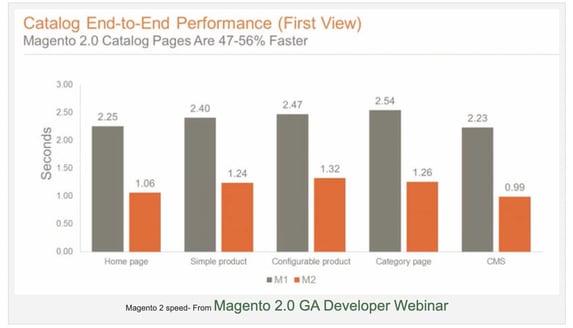
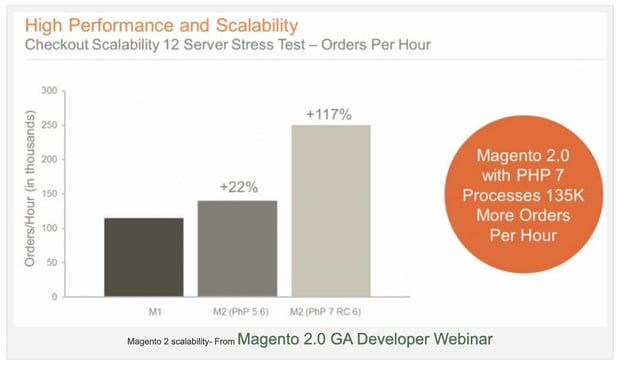
So, if your long-term goal is to grow your ecommerce store and diversify your product offering, then Magento can be the perfect solution for you.
2. Check-out is 38% faster!
Nothing bugs a customer more than a slow checkout process. In fact, it can result in cart abandonment and decreases conversions. According to stats;
- 26% of online shoppers won’t complete the checkout process if it’s too complicated
- 23% of US online consumers have completely abandoned an order because the checkout process is too long or complicated
If you have been struggling with cart abandonment or low conversion rates, this can be a game-changer for your customer's user experience and sales. When migrating to Magento 2, you can expect a 38% faster checkout, as it is more streamlined and has fewer steps which are exactly what a customer wants.
At checkout, customers are given an option to checkout faster with saved information. Or, if it’s a guest, they can create an account in one click from the order “Thank You” page and proceed to checkout. This is impressive!
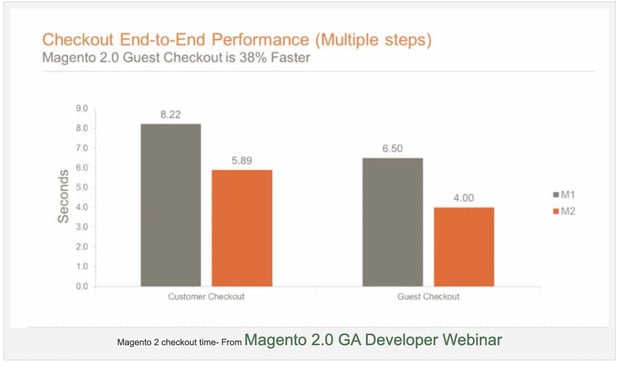
3. It’s mobile-friendly
Mobile commerce has been rapidly growing in the past few years, which makes sense as 7.26 billion people use mobile devices for various purposes as shopping is no doubt one of them. This is why it’s vital for your web store to be able to run on various devices like mobile phones and tablets. This was one of the challenges of Magento 1, but not anymore. The new and improved version has been designed to run well on all devices including smartphones and tablets.
This is an out-of-the-box benefit for all store owners using Magento 2, allowing your customers to enjoy an easy experience where pages are sized for the device.
4. SEO improvements
Even if you didn’t have Magento 1, you must have heard about their ongoing SEO issues somewhere in the grapevine. Well, that is a thing of the past now. Developers have worked tirelessly to improve many SEO elements such as;
- SEO friendly URLs
- Canonical tags for categories and products
- Rich snippets
- Image optimization
- Page speed
- Responsive design
- Meta tags
With Magento 2, increasing traffic and making your web store more visible in the search engine results pages (SERPs) is possible. Increased traffic = increased sales.
5. Better security for your website
Data is a valuable resource, and the risk of losing it can be damaging. As a store owner, you want your data to be safe and to never land in the hands of an unwelcomed guest. Not only does that result in damage to your reputation, but it can cost an SMB up to $25,000 or more. Now, Magento has security features like;
- Timely security scan
- Front-end or back-end CAPTCHA.
- Use two-factor authentication
- Strong passwords requirements
- Advanced admin access permissions
- Strong data encryption
These are some of the security features put in place to ensure web stores have top security, as retail has been expected to be one of the top 10 most attacked industries between 2019 to 2022.
6. Easier admin panel
Running an online store takes a lot of time and effort.
Having a platform that streamlines and makes it easier to manage saves you time and allows you to focus on other things that can bring in sales. Magento 1 was known for having a “hard-to-navigate” admin panel but that has changed.
The new admin interface is user-friendly and easy to learn. Business information can be quickly accessed and comes with 4x faster product import capabilities. When paired with a product information management system that has all your product information in a centralized location, efficiency can be doubled.
With the new interface, you no longer need extensive coding knowledge if you wish to modify your storefront's appearance because the platform now includes a drag-and-drop layout editing feature. This is efficiency at its best.
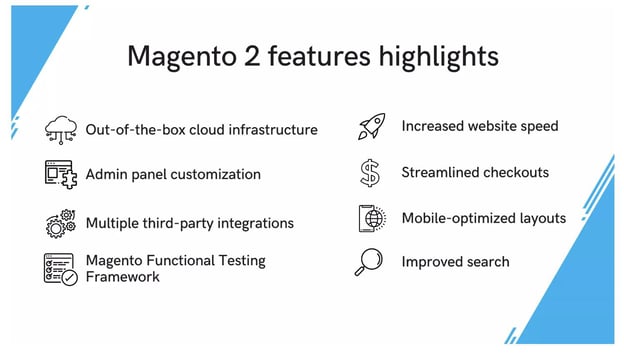
How to make your migration seamless
With the improvements (and the nature of Magento of giving store owners complete freedom over their ecommerce store), it’s no surprise that people would want to migrate. But, what is stopping store owners from moving? Time!
When migrating, there are four components affected. Everything from your data (customer, order, product, etc.) to extensions, themes, customization, and code customizations, are affected. So, here are a few tips to help your migration.
1. Map out the migration process
Mapping the migration process will help everyone involved stay on the same page. Being on the same page throughout the project ensures that there are no steps or components missed that can cause damage, become costly, or waste time on development once your new store is live. Plan thoroughly when it comes to data, for example, how the new ecommerce website should be developed, and a timeline to hold you accountable and ensure the process is moving in a timely manner. Use online tools like InVision when documenting the migration plan.
2. Pre-migration testing is key
Migrating isn’t a drag and drop type of thing; functionalities from your existing platform won’t be the same. Pre-migration testing helps you ensure you don’t have issues that may cause downtime at a later stage. Every minute lost during downtime is the money going to your competitors, for instance, Amazon lost $220,318.80 per minute, Walmart lost $40,771.20 lost per minute. Prepare a separate testing environment on a dedicated server for migration and development. This will ensure that you don’t need to experience downtime.
3. Decide if you want to migrate your theme or not
Even if you’re coming from Magento 1, you may want to consider using a new theme, and giving your web store a fresh look. The theme you have now will be incompatible with Magento 2, and you’ll need to move it manually. Be prepared as this will become time-consuming. So, take a look at the themes available and see what inspires you especially if you’re trying to cut back on migration time.
4. Make SEO a top priority
Unfortunately, one of the cons of a site migration is that it may result in a temporary loss of traffic. This is because Google needs time to update its index.
In saying that;
- Make sure you try and plan your migration during a slower season as it will help ensure you don’t lose traffic during the busiest time for your business
- Crawl your existing site before migration to ensure no link/URL is lost
- Self-canonicalize all-new pages so that your new site gets indexed by Google
- Monitor traffic, performance, and rankings
5. Take care of your product data
Your data is one of your most valuable assets, so you need to ensure it is accurate, sorted, and backed up. Backing up important data will ensure you have an additional layer of safety. That way your data cannot be lost and will be easy to recover if needed. You can use the best suited PIM for Magento and easily store all your product data rather than using spreadsheets and excel folders.
Migrating is a time-consuming process that needs you to automate procedures as best as possible, so why not have a platform to help handle this? You’ll also be able to transfer your data to your new Magento 2 site seamlessly in half the time.
It’s time to migrate!
If you had any doubts, we hope we made it clear that now's the time to migrate to Magento 2. Besides offering an impressive ecommerce experience, they are also one of the best headless commerce platforms, and their interface is easy to learn and master. It integrates well with other tools and has pre-built integrations.
Read this free white paper for more information on multichannel commerce and channel integrations after you’ve migrated to Magento. Need a hand? Ask us!

What if your product data actually worked for you?
We’ll show you how Plytix helps you stop fixing data—and start using it.
Related posts
Keep the good stuff coming
Subscribe to our blog newsletter and get monthly content that helps you manage product data smarter.
No spam. Just real value.
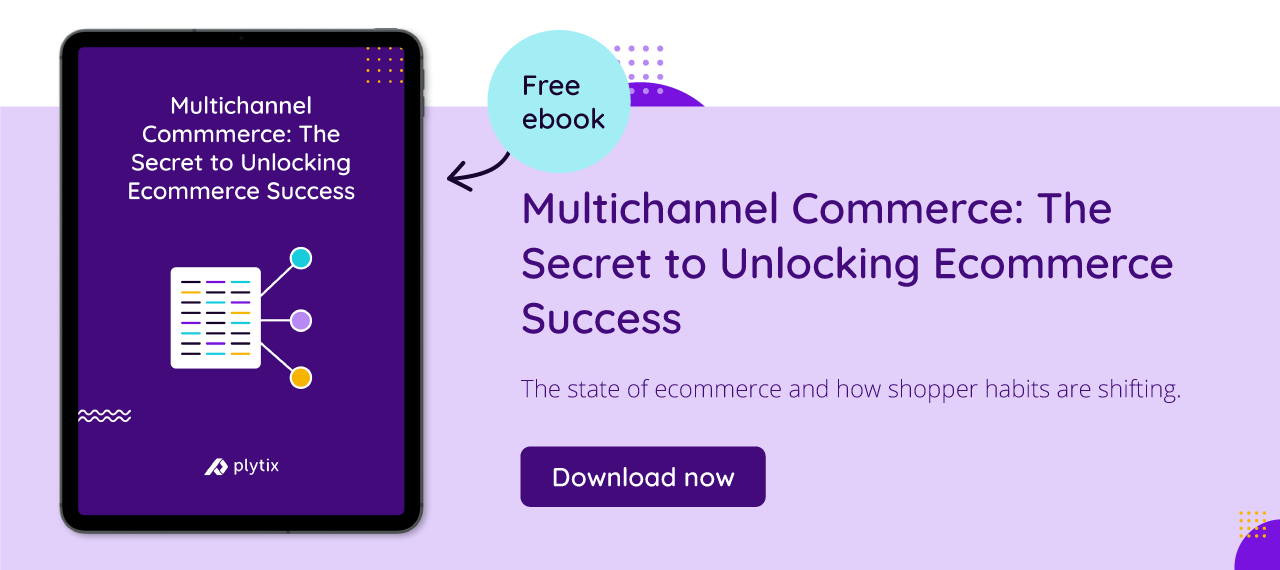





Think others should see this?
Go ahead and share it.